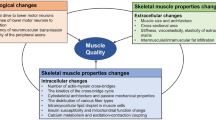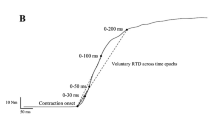Abstract
Purpose
Changes in stiffness or extensibility of the muscle or muscle–tendon unit with aging could lead to impaired function and an increased vulnerability to injury. We aimed to investigate the passive force and viscoelastic properties of single muscle fibers in older adults.
Methods
Seven older adults (mean age 79.0 ± 3.8 years) and 10 young control (mean age 25.6 ± 4.5 years) were recruited. Biopsy specimens were obtained percutaneously from m. vastus lateralis and skinned single fibers were used for the experiments. Slack tests were performed to determine maximal force and maximal unloaded shortening velocity. Passive force was measured in pCa 9.0 solution using a stepwise stretch technique with increment of sarcomere length from 2.4 to 4.2 µm. Myosin heavy chain (MHC) isoform was determined by sodium dodecyl sulfate–polyacrylamide gel electrophoresis. Specific force was calculated as maximal force divided by cross-sectional area. Passive force, peak passive force, time to half stress relaxation (T1/2) and force decay index (a force time integral under a stress relaxation curve) were measured.
Results
No difference between the groups were found in specific force and shortening velocity. Passive force and peak passive force were greater in both MHC I and IIa fibers of older adults (p < 0.001, p = 0.012, respectively, at 4.2 mm SL). Force decay index was higher in older adults. (p = 0.001 at 4.2 µm SL). There were no significant differences in passive force and viscoelastic properties between fiber types.
Conclusion
We demonstrated greater passive force and viscoelastic properties at the level of single fibers in older adults.




Similar content being viewed by others
References
Blanpied P, Smidt GL (1993) The difference in stiffness of the active plantarflexors between young and elderly human females. J Gerontol 48(2):M58–M63
Brown M, Fisher JS, Salsich G (1999) Stiffness and muscle function with age and reduced muscle use. J Orthop Res 17(3):409–414. https://doi.org/10.1002/jor.1100170317
Candow DG, Chilibeck PD (2005) Differences in size, strength, and power of upper and lower body muscle groups in young and older men. J Gerontol A Biol Sci Med Sci 60(2):148–156
Canepari M, Pellegrino MA, D'Antona G, Bottinelli R (2010) Single muscle fiber properties in aging and disuse. Scand J Med Sci Sports 20(1):10–19. https://doi.org/10.1111/j.1600-0838.2009.00965.x
Canon F, Goubel F (1995) Changes in stiffness induced by hindlimb suspension in rat soleus muscle. Pflugers Arch 429(3):332–337
Chesworth BM, Vandervoort AA (1989) Age and passive ankle stiffness in healthy women. Phys Ther 69(3):217–224
Choi SJ, Kim S, Lim JY (2011) Potential errors in fiber length measurements resulting from lever arm rotation during mechanical testing of muscle cells. J Biomech 44(9):1797–1800. https://doi.org/10.1016/j.jbiomech.2011.03.027
Craig CL, Marshall AL, Sjostrom M, Bauman AE, Booth ML, Ainsworth BE, Oja P (2003) International physical activity questionnaire: 12-country reliability and validity. Med Sci Sports Exerc 35(8):1381–1395. https://doi.org/10.1249/01.MSS.0000078924.61453.FB
Dow DE, Dennis RG, Faulkner JA (2005) Electrical stimulation attenuates denervation and age-related atrophy in extensor digitorum longus muscles of old rats. J Gerontol A Biol Sci Med Sci 60(4):416–424
Friden J, Lieber RL (2003) Spastic muscle cells are shorter and stiffer than normal cells. Muscle Nerve 27(2):157–164. https://doi.org/10.1002/mus.10247
Frontera WR, Hughes VA, Krivickas LS, Roubenoff R (2001) Contractile properties of aging skeletal muscle. Int J Sport Nutr Exerc Metab 11(Suppl):S16–20
Frontera WR, Reid KF, Phillips EM, Krivickas LS, Hughes VA, Roubenoff R, Fielding RA (2008) Muscle fiber size and function in elderly humans: a longitudinal study. J Appl Physiol 105(2):637–642. https://doi.org/10.1152/japplphysiol.90332.2008
Gajdosik RL, Vander Linden DW, Williams AK (1999) Influence of age on length and passive elastic stiffness characteristics of the calf muscle-tendon unit of women. Phys Ther 79(9):827–838
Gajdosik RL, Vander Linden DW, McNair PJ, Riggin TJ, Albertson JS, Mattick DJ, Wegley JC (2005) Viscoelastic properties of short calf muscle-tendon units of older women: effects of slow and fast passive dorsiflexion stretches in vivo. Eur J Appl Physiol 95(2–3):131–139. https://doi.org/10.1007/s00421-005-1394-4
Gao Y, Kostrominova TY, Faulkner JA, Wineman AS (2008) Age-related changes in the mechanical properties of the epimysium in skeletal muscles of rats. J Biomech 41(2):465–469. https://doi.org/10.1016/j.jbiomech.2007.09.021
George NT, Irving TC, Williams CD, Daniel TL (2013) The cross-bridge spring: can cool muscles store elastic energy? Science 340(6137):1217–1220. https://doi.org/10.1126/science.1229573
Gollapudi SK, Lin DC (2009) Experimental determination of sarcomere force-length relationship in type-I human skeletal muscle fibers. J Biomech 42(13):2011–2016. https://doi.org/10.1016/j.jbiomech.2009.06.013
Granzier H, Labeit S (2007) Structure-function relations of the giant elastic protein titin in striated and smooth muscle cells. Muscle Nerve 36(6):740–755. https://doi.org/10.1002/mus.20886
Grosicki GJ, Standley RA, Murach KA, Raue U, Minchev K, Coen PM, Health ABCS (2016) Improved single muscle fiber quality in the oldest-old. J Appl Physiol (1985) 121(4):878–884. https://doi.org/10.1152/japplphysiol.00479.2016
Guralnik JM, Ferrucci L, Pieper CF, Leveille SG, Markides KS, Ostir GV, Wallace RB (2000) Lower extremity function and subsequent disability: consistency across studies, predictive models, and value of gait speed alone compared with the short physical performance battery. J Gerontol A Biol Sci Med Sci 55(4):M221–231
Horowits R (1992) Passive force generation and titin isoforms in mammalian skeletal muscle. Biophys J 61(2):392–398. https://doi.org/10.1016/S0006-3495(92)81845-3
Krivickas LS, Suh D, Wilkins J, Hughes VA, Roubenoff R, Frontera WR (2001) Age- and gender-related differences in maximum shortening velocity of skeletal muscle fibers. Am J Phys Med Rehabil 80(6):447–455 (quiz 456–447)
Krivickas LS, Fielding RA, Murray A, Callahan D, Johansson A, Dorer DJ, Frontera WR (2006) Sex differences in single muscle fiber power in older adults. Med Sci Sports Exerc 38(1):57–63
Larsson L, Moss RL (1993) Maximum velocity of shortening in relation to myosin isoform composition in single fibres from human skeletal muscles. J Physiol 472:595–614
Larsson L, Salviati G (1992) A technique for studies of the contractile apparatus in single human muscle fibre segments obtained by percutaneous biopsy. Acta Physiol Scand 146(4):485–495. https://doi.org/10.1111/j.1748-1716.1992.tb09450.x
Linke WA (2000) Stretching molecular springs: elasticity of titin filaments in vertebrate striated muscle. Histol Histopathol 15(3):799–811. https://doi.org/10.14670/HH-15.799
Maganaris CN (2001) Force-length characteristics of in vivo human skeletal muscle. Acta Physiol Scand 172(4):279–285. https://doi.org/10.1046/j.1365-201x.2001.00799.x
Magnusson SP (1998) Passive properties of human skeletal muscle during stretch maneuvers. A review. Scand J Med Sci Sports 8(2):65–77
Meyer GA, McCulloch AD, Lieber RL (2011) A nonlinear model of passive muscle viscosity. J Biomech Eng 133(9):091007. https://doi.org/10.1115/1.4004993
Minajeva A, Kulke M, Fernandez JM, Linke WA (2001) Unfolding of titin domains explains the viscoelastic behavior of skeletal myofibrils. Biophys J 80(3):1442–1451. https://doi.org/10.1016/S0006-3495(01)76116-4
Moss RL (1979) Sarcomere length-tension relations of frog skinned muscle fibres during calcium activation at short lengths. J Physiol 292:177–192
Nam S, Hu KH, Butte MJ, Chaudhuri O (2016) Strain-enhanced stress relaxation impacts nonlinear elasticity in collagen gels. Proc Natl Acad Sci USA 113(20):5492–5497. https://doi.org/10.1073/pnas.1523906113
Ochala J, Frontera WR, Dorer DJ, Van Hoecke J, Krivickas LS (2007) Single skeletal muscle fiber elastic and contractile characteristics in young and older men. J Gerontol A Biol Sci Med Sci 62(4):375–381
Olsson MC, Kruger M, Meyer LH, Ahnlund L, Gransberg L, Linke WA, Larsson L (2006) Fibre type-specific increase in passive muscle tension in spinal cord-injured subjects with spasticity. J Physiol 577(Pt 1):339–352. https://doi.org/10.1113/jphysiol.2006.116749
Palmer TB, Thompson BJ (2017) Influence of age on passive stiffness and size, quality, and strength characteristics. Muscle Nerve 55(3):305–315. https://doi.org/10.1002/mus.25231
Payne AM, Delbono O (2004) Neurogenesis of excitation-contraction uncoupling in aging skeletal muscle. Exerc Sport Sci Rev 32(1):36–40
Prado LG, Makarenko I, Andresen C, Kruger M, Opitz CA, Linke WA (2005) Isoform diversity of giant proteins in relation to passive and active contractile properties of rabbit skeletal muscles. J Gen Physiol 126(5):461–480. https://doi.org/10.1085/jgp.200509364
Siu PM, Pistilli EE, Butler DC, Alway SE (2005) Aging influences cellular and molecular responses of apoptosis to skeletal muscle unloading. Am J Physiol Cell Physiol 288(2):C338–349. https://doi.org/10.1152/ajpcell.00239.2004
Siu PM, Pistilli EE, Murlasits Z, Alway SE (2006) Hindlimb unloading increases muscle content of cytosolic but not nuclear Id2 and p53 proteins in young adult and aged rats. J Appl Physiol 100(3):907–916. https://doi.org/10.1152/japplphysiol.01012.2005
Toursel T, Stevens L, Granzier H, Mounier Y (2002) Passive tension of rat skeletal soleus muscle fibers: effects of unloading conditions. J Appl Physiol 92(4):1465–1472. https://doi.org/10.1152/japplphysiol.00621.2001
Trombitas K, Wu Y, McNabb M, Greaser M, Kellermayer MS, Labeit S, Granzier H (2003) Molecular basis of passive stress relaxation in human soleus fibers: assessment of the role of immunoglobulin-like domain unfolding. Biophys J 85(5):3142–3153. https://doi.org/10.1016/S0006-3495(03)74732-8
Vincent J (2012) Structural biomaterials, 3rd edn. Princeton University Press, Princeton
Walston J, Fried LP (1999) Frailty and the older man. Med Clin N Am 83(5):1173–1194
Weppler CH, Magnusson SP (2010) Increasing muscle extensibility: a matter of increasing length or modifying sensation? Phys Ther 90(3):438–449. https://doi.org/10.2522/ptj.20090012
Winegard KJ, Hicks AL, Vandervoort AA (1997) An evaluation of the length-tension relationship in elderly human plantarflexor muscles. J Gerontol A Biol Sci Med Sci 52(6):B337–343
Wood LK, Kayupov E, Gumucio JP, Mendias CL, Claflin DR, Brooks SV (2014) Intrinsic stiffness of extracellular matrix increases with age in skeletal muscles of mice. J Appl Physiol (1985) 117(4):363–369. https://doi.org/10.1152/japplphysiol.00256.2014
Acknowledgements
This study is dedicated to the memory of Dr. Lisa S. Kirivickas. This study was supported by the Academic Grant of Harvard Medical School and the National Research Foundation of Korea (Grant NRF—800-20160360) and the National Institutes of Health, USA (Grant S21MD001830) to FWR. We thank Harrat, Hynd Chehla and Nibaldi, Eva Golenko for their help with experimental procedures.
Author information
Authors and Affiliations
Contributions
FWR and LJY designed and coordinated the study. LJY and PEM collected the clinical samples and clinical data. LJY and CSJ performed the laboratory work and analyzed the data. WJJ and FWR were involved in the planning and supervised the work. All the authors discussed the results and contributed to the manuscript.
Corresponding author
Ethics declarations
Conflict of interest
The author(s) declare that they have no competing interests.
Additional information
Communicated by Nicolas Place.
Publisher's Note
Springer Nature remains neutral with regard to jurisdictional claims in published maps and institutional affiliations.
Rights and permissions
About this article
Cite this article
Lim, JY., Choi, S.J., Widrick, J.J. et al. Passive force and viscoelastic properties of single fibers in human aging muscles. Eur J Appl Physiol 119, 2339–2348 (2019). https://doi.org/10.1007/s00421-019-04221-7
Received:
Accepted:
Published:
Issue Date:
DOI: https://doi.org/10.1007/s00421-019-04221-7




